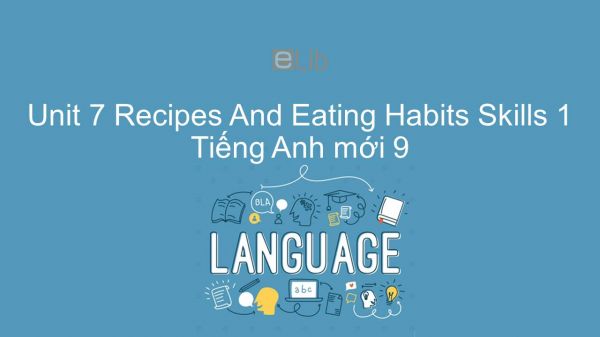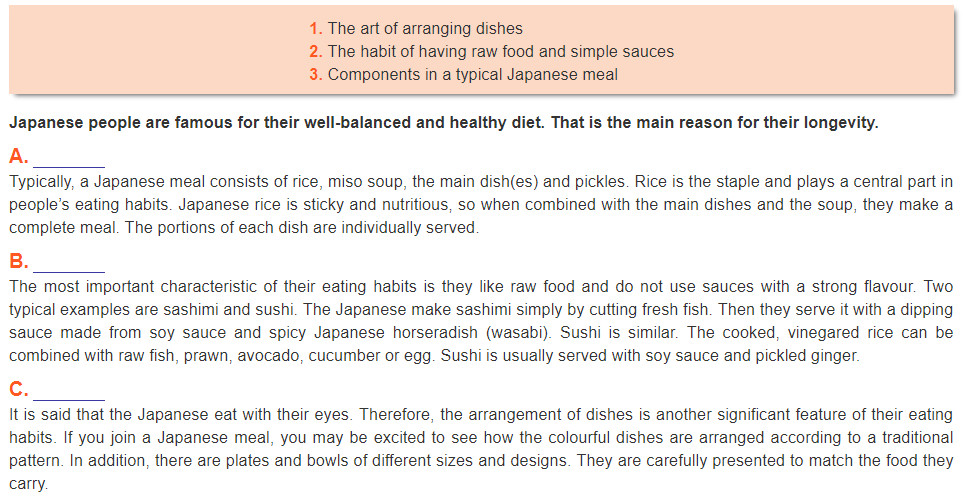Unit 7 lớp 9: Recipes And Eating Habits - Skills 1
Nhằm giúp các em rèn luyện hai kĩ năng quan trọng trong tiếng Anh là Reading và Speaking, phần Skills 1 hướng dẫn các em trả lời các câu hỏi câu hỏi về thói quen ăn của người Nhật và luyện tập nói về thói quen ăn uống của người Việt Nam.
Mục lục nội dung

Unit 7 lớp 9: Recipes And Eating Habits - Skills 1
1. Reading
1.1. Task 1 Unit 7 lớp 9
Work in pairs. Answer the questions. (Làm việc theo nhóm. Trả lời những câu hỏi.)

1. What can you see in each picture? (Bạn nhìn thấy gì trong mỗi bức tranh)
2. Have you ever tried the dishes in the pictures? If so, how did you find them?
(Bạn đã bao giờ thử các món như trong hình? Nếu có, bạn đã thưởng thức món ăn đó trong hoàn cảnh nào?)
Guide to answer
1. Picture A: different types of sushi (các loại sushi khác nhau)
Picture B: miso soup (súp miso)
Picture C: a bowl of rice (1 bát cơm)
Picture D: sliced cucumber/pickled cucumber (dưa chuột đã thái/ dưa chuột muối)
2. I have never tried the dishes. (Tôi chưa bao giờ thử những món này)
1.2. Task 2 Unit 7 lớp 9
Now read an article about Japanese eating habits. Match the headings (1-3) with the paragraphs (A-C). (Bây giờ hãy đọc bài báo về thói quen ăn của người Nhật. Nối các tiêu đề (1-3) với các đoạn băng (A-C).

Guide to answer
A.3 B.2 C.1
Tạm dịch:
Người Nhật nổi tiếng với chế độ ăn uống cân bằng và lành mạnh. Đó là lí do chính giúp họ có tuổi thọ cao.
A. Thành phần trong một bữa ăn điển hình của người Nhật
Thông thường, một bữa ăn Nhật Bản bao gồm cơm, súp miso, (các) món chính và dưa chua. Gạo là lương thực và đóng một vai trò trung tâm trong thói quen ăn uống của mọi người. Gạo Nhật Bản rất dẻo và giàu dinh dưỡng vì vậy khi kết hợp với các món chính và súp sẽ tạo nên một bữa ăn hoàn chỉnh. Các phần của mỗi món ăn được phục vụ riêng.
B. Thói quen ăn sống và nước sốt đơn giản
Đặc điểm quan trọng nhất trong thói quen ăn uống của họ là họ thích ăn thức ăn sống và không sử dụng nước sốt với hương vị đậm. Hai ví dụ điển hình là sashimi và sushi. Người Nhật làm sashimi đơn giản bằng cách cắt cá tươi. Sau đó, họ phục vụ nó kèm với nước chấm làm từ nước tương và cải ngựa Nhật Bản cay (wasabi). Sushi cũng tương tự. Cơm đã được nấu chín, ngâm giấm có thể kết hợp với cá sống, tôm, bơ, dưa chuột hoặc trứng. Sushi thường được ăn kèm với nước tương và gừng ngâm chua.
C. Nghệ thuật của việc sắp xếp món ăn
Người ta nói rằng người Nhật ăn bằng mắt. Vì vậy, cách sắp xếp các món ăn là một đặc điểm quan trọng khác trong thói quen ăn uống của họ. Nếu bạn tham gia vào một bữa ăn của người Nhật, bạn có thể sẽ rất hào hứng khi thấy những món ăn đầy màu sắc được sắp xếp theo khuôn mẫu truyền thống như thế nào. Ngoài ra, có đĩa và bát với nhiều kích thước và thiết kế khác nhau. Chúng được trình bày cẩn thận để phù hợp với thực phẩm mà chúng mang theo.
1.3. Task 3 Unit 7 lớp 9
Read the article again and answer the questions. (Đọc bài viết lại một lần nữa và trả lời các câu hỏi.)
1. What is the most important feature of Japanese eating habits?
(Đặc trưng quan trọng nhất trong thói quen ăn của người Nhật là gì?)
2. How do they make sashimi? (Họ làm món "sashimi" như thế nào?)
3. What sauce can both sashimi and sushi be served with?
(Nước sốt nào được dùng với cả món sashimi và sushi?)
4. How many components are there in a typical Japanese meal?
(Có bao nhiêu thành phần trong bữa ăn điển hình của người Nhật?)
5. How is rice important in Japanese meals?
(Tầm quan trọng của cơm trong bữa ăn của người Nhật như thế nào?)
6. Why do people say that the Japanese eat with their eyes?
(Tại sao người ta nói rằng người Nhật ăn bằng mắt?)
Guide to answer
1. They like raw food and do not use sauces with a strong flavour.
(Họ thích thực phẩm sống và không dùng với nước chấm với hương vị quá đậm)
2. They cut fresh fish. (Họ cắt cá tươi)
3. Both can be served with soy sauce. (Cả hai đều có thể dùng với nước tương)
4. There are four (rice, miso soup, main dish(es), pickles).
(Có 4 món - cơm, canh miso, các món chính, dưa muối)
5. Rice is the staple food and is very nutritious. (Cơm là thành phần chính và rất dinh dưỡng)
6. Because the dishes are presented in different bowls and plates, and are arranged carefully according to a traditional pattern.
(Bởi vì những món ăn được trình bày trong những chiếc đĩa và bát, và được sắp xếp cẩn thận theo phong cách truyền thống)
2. Speaking
2.1. Task 4 Unit 7 lớp 9
Work in groups. Discuss the eating habits of Vietnamese people. You can use the following questions as cues. (Làm việc theo nhóm. Thảo luận về thói quen ăn của người Việt Nam. Bạn có thể sử dụng các câu hỏi dưới đây để làm gợi ý.)
1. What is the most important feature of Vietnamese eating habits?
(Đặc trưng quan trọng nhất trong thói quen ăn của người Việt Nam là gì?)
2. What are the typical components in a Vietnamese meal?
(Thành phần trong bữa ăn điển hình của người Việt là gì?)
3. What is the staple of our country? (Món gì là thành phần chính?)
4. How are the dishes arranged?
(Các món ăn được sắp xếp như thế nào?)
5. Are there any other characteristics of our eating habits that you know?
(Có những đặc điểm nào khác trong thói quen ăn của người Việt mà bạn biết?)
6. In general, do Vietnamese people have healthy eating habits?
(Nhìn chung, người Việt Nam có thói quen ăn uống tốt cho sức khỏe không?)
Guide to answer
1. Vietnamese people usually have big dinner with at least 3 dishes and use many kinds of special sauces for each dish.
(Người Việt thường có bữa ăn tối lớn với ít nhất 3 món ăn và sử dụng nhiều loại nước sốt đặc biệt cho mỗi món. )
2. Rice is the typical components in a Vietnamese meal.
(Cơm là thành phần đặc trưng trong bữa ăn của người Việt.)
3. Rice. (Cơm)
4. a tray of food with a small bowl of sauce in the middle.
(1 mâm thức ăn với một bát nhỏ nước chấm ở giữa. )
5. Vegetable and soup are two dishes that always appear in a typical Vietnamese meal; after a meal, we usually eat fruit for desserts.
(Rau và canh là 2 món ăn thường xuất hiện trong bữa ăn của người Việt. Sau bữa cơm, chúng tôi thường ăn hoa quả là món tráng miệng.)
6. Yes, because we eat a lot of vegetables and fruits. (Có vì chúng tôi ăn rất nhiều rau quả.)
2.2. Task 5 Unit 7 lớp 9
Imagine that you take part in an international competition in which competitors talk about the eating habits of their own country. Present your group's ideas about Vietnamese eating habits. (Tưởng tượng rằng bạn tham gia vào một cuộc thi quốc tế trong đó các ứng cử viên nói về thói quen ăn của đất nước họ. Trình bày ý tưởng của nhóm bạn về thói quen ẩm thực của người Việt Nam.)
Guide to answer
Vietnamese eating habits
Traditional Vietnamese cooking usually uses fresh ingredients, little dairy and oil, and various herbs and vegetables. Different sauces such as fish sauce, shrimp paste, and soya sauce are quite popular in various regions.
A meal consists of various dishes: main dish (meat, fish, egg or tofu), vegetable, soup and rice. Rice is the staple in Viet Nam. In many families, people eat around a tray of food with a small bowl of fish sauce in the middle. Around this bowl are the dishes. If people place the food on a table, a similar arrangement is followed. Dishes are served communally. Usually there is a big dish/ bowl of each dish, and people use chopsticks and spoons to get their share.
In general, Vietnamese food is considered healthy and is popular in other countries.
Tạm dịch:
Thói quen ăn uống của người Việt Nam
Món ăn truyền thống Việt Nam thường sử dụng các nguyên liệu tươi, ít sữa và dầu, và nhiều loại thảo mộc và rau. Các loại nước sốt khác nhau như nước mắm, tôm , nước tương tương đối phổ biến ở nhiều vùng khác nhau.
Một bữa ăn bao gồm các món ăn khác nhau: món chính (thịt, cá, trứng hoặc đậu phụ), rau, súp và cơm. Gạo là mặt hàng chủ lực của Việt Nam. Ở nhiều gia đình, mọi người ăn chung một mâm thức ăn với một bát nhỏ nước mắm ở giữa. Xung quanh bát này là những món ăn. Nếu người ta đặt thức ăn trên bàn, thì cũng có một sự sắp xếp tương tự. Món ăn được phục vụ cộng đồng. Thông thường có một món ăn/ bát mỗi món ăn, và mọi người sử dụng đũa và muỗng để có được chia sẻ của họ.
Nhìn chung, thực phẩm Việt Nam được coi là lành mạnh và phổ biến ở các nước khác.
3. Practice Task 1
Read the text and decide T (true)/ F (false) for each statement.
FOOD OF TYPICAL WET RICE COUNTRY
Vietnamese sometime wonder how westerners can eat bread days after days but the vice-versa also holds water. Most tourists coming to Vietnam are amazed at the omni-presence of rice and rice-related dishes.
Rice is an object for worshipping in many temples of Vietnam. It is said to originate from the Mother Godness Worshipping, the most long–standing belief in Vietnam. Yes rice is a big thing out here. The very first written characters constituting the word “Happiness” in ancient Vietnamese is the image of many rice plants and a square symbolizing a paddy field. Rice is not only happiness, it really forms Vietnamese.
Accordingly, many main dishes and snacks in Vietnam are made from rice: boiled rice in daily meal, rice porridge, steamed rice, glutinous rice cake, well-known Banh Chung (square cake) and uncountable made-from rice dishes from every region in Vietnam.
Even the universal Pho that you definitely hear about is made from rice as well. Rice is the center of everything, like a sun lying in the center of the whole solar planet.
Considering rice important, Vietnamese has been always developing their farming method and new rice genres. Many Vietnam rice varieties exported to all over the world are renowned for their distinctive flavor, yet only when coming to Vietnam and have boiled rice with soya sauce pickled egg-plants, your adventure to Vietnam is considered perfect.
Question 1: Few tourists coming to Vietnam are amazed at the omni-presence of rice and rice-related dishes
Question 2: Rice is an object for worshipping in many temples of Vietnam.
Question 3: Few main dishes and snacks in Vietnam are made from rice.
Question 4: Pho is one of the most popular dishes made from rice.
Question 5: Vietnamese rice is exported to lots of countries in the world.
4. Practice Task 2
Read the article, and choose the correct answer A, B, C or D for each question.
Simple Ways to Lose Weight on a Budget
Plan to Cook at Home
Instead of buying costly prepared meals, which often tend to be high in calories, cook your own at home. Plan out your meals with high-fiber foods like beans and whole grains which will keep you full and are a cheaper, healthier alternative to rich proteins and more processed grains.
Eat Less
Eating less leads to weight loss, and cost savings, especially if you cut down on the right things. Start by cutting your portions of pricy meat and poultry. Double Up on Vegetables
Vegetables are great for weight loss, as well as all-around health. They are low in calories and high in water and fiber - two things that keep you feeling full. Save cash by shopping for those that are in season. Frozen vegetables can be a great bargain, with just as much nutrition as fresh, since they are picked and frozen at their peak ripeness.
Get Creative with Your Exercise Options
You don’t need to shell out a monthly gym fee to get moving. Instead, find fun activities you enjoy for free. If you’re just getting started with a regular exercise routine, try your beginning with daily walks: start slowly and build up time and speed.
Make Friends with Someone
One of the most powerful resources you have for helping you lose weight is your social network. Find a friend who is also trying to lose weight and agree to help each other stay motivated. One study found that when friends participated in a group weight-loss programme together, they lost more weight than people who did the same programme on their own.
Question 1: The advantage of cooking at home is ………..
A. to have food that is high in calories
B. to enjoy a variety of rich proteins and more processed grains
C. to plan out your costly prepared meals
D. to choose foods that keep you full and is cheaper
Question 2: In order to cut down on your daily calories, you should do all the following things EXCEPT ………….
A. follow vegetarian diets for your meals
B. eat less meat and poultry
C. eat more beans, lentils, tofu and eggs
D. cut down on animal proteins for some of your meals
Question 3: All of the following are true about vegetables EXCEPT that ……….
A. vegetables can keep you feeling full
B. they help you lose weight effectively
C. frozen vegetables are not good for your health
D. you feel healthier and save money with fresh vegetables in season
Question 4: We can infer from the article that ………….
A. you should join in a social network instead of going to a gym
B. a partner can make you feel more motivated in losing weight
C. you should find fun activities at the gym and follow them
D. joining a programme you can lose more weight than your partner
Question 5: The phrase “shell out” is closest in meaning to………….
A. become more interested in something
B. pay money for something
C. peel something out
D. take someone out of a shell
5. Conclusion
Kết thúc bài học các em cần luyện đọc, luyện nói và ghi nhớ các từ vựng sau:
- arrange dish: bài trí món ăn
- raw food: đồ ăn tươi sống
- component (n): thành phần
- typically (adv): một cách đặc trưng
- pickles (n): dưa hành muối
- eating habit: thói quen ăn uống
- portion (n): khẩu phần
- individually (adv): theo cá nhân
- flavour (n): vị
- soy sauce: nước tương
- vinegared (adj): được ngâm dấm
- cucumber (n): dưa chuột
- ginger (n): gừng
Tham khảo thêm
- doc Unit 7 lớp 10: Recipes And Eating Habits - Getting Started
- doc Unit 7 lớp 9: Recipes And Eating Habits - A Closer Look 1
- doc Unit 7 lớp 9: Recipes And Eating Habits - A Closer Look 2
- doc Unit 7 lớp 9: Recipes And Eating Habits - Communication
- doc Unit 7 lớp 9: Recipes And Eating Habits - Skills 2
- doc Unit 7 lớp 9: Recipes And Eating Habits - Looking Back
- doc Unit 7 lớp 9: Recipes And Eating Habits - Project

